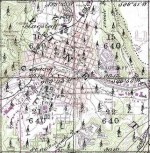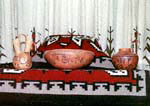Influence of Railroads in Flagstaff
 The railroad has had a pervasive influence in Flagstaff, from the beginning of the town throughout its history. Even though the first settlers in Flagstaff arrived before the railroad, these sheep ranchers lived in dispersed locations in the area wherever there was grass and water. The arrival of the railroad was followed by profound changes in population, real estate, the landscape, and culture. The railroad has had a pervasive influence in Flagstaff, from the beginning of the town throughout its history. Even though the first settlers in Flagstaff arrived before the railroad, these sheep ranchers lived in dispersed locations in the area wherever there was grass and water. The arrival of the railroad was followed by profound changes in population, real estate, the landscape, and culture.
 In 1880, the Atlantic and Pacific Railroad began working on the line from Albuquerque to California. Later that year, a small community of merchants, saloon keepers, and cafe owners established the camp at Old Town Spring to supply the needs of the railroad workers. The trains arrived in Flagstaff in 1882. In 1883, the depot was constructed on level ground to the east. The same year, P. J. Brannen moved his store from Old Town to north of the depot, and the town grew up around this early center. In 1880, the Atlantic and Pacific Railroad began working on the line from Albuquerque to California. Later that year, a small community of merchants, saloon keepers, and cafe owners established the camp at Old Town Spring to supply the needs of the railroad workers. The trains arrived in Flagstaff in 1882. In 1883, the depot was constructed on level ground to the east. The same year, P. J. Brannen moved his store from Old Town to north of the depot, and the town grew up around this early center.
 Before the railroad arrived, it was not economical to move cattle from Flagstaff to market. Once the train provided transportation, cattle ranches sprang up in the Flagstaff area. Up until the 1890s there was open range, so that a rancher could graze and water his stock almost anywhere. Then the government surveyors marked boundaries, and by the turn of the century the range was fenced. The largest early cattle ranch was located in Ft Valley at Ft Moroni, built by John Young, son of the Mormon Brigham Young of Utah. The Rio de Flag runs through this meadow in Ft Valley. Before the railroad arrived, it was not economical to move cattle from Flagstaff to market. Once the train provided transportation, cattle ranches sprang up in the Flagstaff area. Up until the 1890s there was open range, so that a rancher could graze and water his stock almost anywhere. Then the government surveyors marked boundaries, and by the turn of the century the range was fenced. The largest early cattle ranch was located in Ft Valley at Ft Moroni, built by John Young, son of the Mormon Brigham Young of Utah. The Rio de Flag runs through this meadow in Ft Valley.
 In compensation for laying the rails across the country, the railroads were given every other section of land for 20 miles on either side of the tracks. The depot was located north of the tracks at Leroux Street. Railroad Avenue (renamed Santa Fe in 1926 and Route 66 in 1992) was the main street of the town, running parallel to the tracks north of the depot. Of the four sections of land in the center of Flagstaff, the railroad owned sections 15 (northeast) and 21 (southwest). Commercial construction east of San Francisco Street began on section 15 before the railroad surveyed it. Subsequently, the railroad dedicated some of its land to the new town, both for commercial purposes and private. The railroad sold much of its timbered land to lumber interests and its range land to cattle interests. In compensation for laying the rails across the country, the railroads were given every other section of land for 20 miles on either side of the tracks. The depot was located north of the tracks at Leroux Street. Railroad Avenue (renamed Santa Fe in 1926 and Route 66 in 1992) was the main street of the town, running parallel to the tracks north of the depot. Of the four sections of land in the center of Flagstaff, the railroad owned sections 15 (northeast) and 21 (southwest). Commercial construction east of San Francisco Street began on section 15 before the railroad surveyed it. Subsequently, the railroad dedicated some of its land to the new town, both for commercial purposes and private. The railroad sold much of its timbered land to lumber interests and its range land to cattle interests.
 E. E. Ayer constructed the first lumber mill in Flagstaff. He later sold it to D. M. Riordan in 1887, who with his brothers ran the dominant Arizona Timber and Lumber Company and built much of Flagstaff. Logging railroads were built into the forest to establish the logging camps and transport the downed trees to the mill. Large trees made logging relatively easy and very profitable. After an area was cut, the rails were laid to a new site to repeat the process. In the forest today, remnants of these old railroad grades can still be found. E. E. Ayer constructed the first lumber mill in Flagstaff. He later sold it to D. M. Riordan in 1887, who with his brothers ran the dominant Arizona Timber and Lumber Company and built much of Flagstaff. Logging railroads were built into the forest to establish the logging camps and transport the downed trees to the mill. Large trees made logging relatively easy and very profitable. After an area was cut, the rails were laid to a new site to repeat the process. In the forest today, remnants of these old railroad grades can still be found.
 As tourists rode the rails to Flagstaff, they could reach areas virtually inaccessible previously. Not only were the natural wonders of the landscape an attraction, but more people were introduced to the culture of Native Americans. It seemed that the interest from both tourists and museum curators stimulated the creative spirit among Indian artists of pottery, blankets, and jewelry. As tourists rode the rails to Flagstaff, they could reach areas virtually inaccessible previously. Not only were the natural wonders of the landscape an attraction, but more people were introduced to the culture of Native Americans. It seemed that the interest from both tourists and museum curators stimulated the creative spirit among Indian artists of pottery, blankets, and jewelry.
|

 The railroad has had a pervasive influence in Flagstaff, from the beginning of the town throughout its history. Even though the first settlers in Flagstaff arrived before the railroad, these sheep ranchers lived in dispersed locations in the area wherever there was grass and water. The arrival of the railroad was followed by profound changes in population, real estate, the landscape, and culture.
The railroad has had a pervasive influence in Flagstaff, from the beginning of the town throughout its history. Even though the first settlers in Flagstaff arrived before the railroad, these sheep ranchers lived in dispersed locations in the area wherever there was grass and water. The arrival of the railroad was followed by profound changes in population, real estate, the landscape, and culture.




